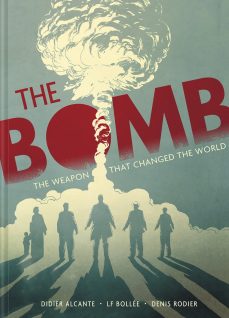The Weapon That Changed the World
Didier Alcante and Laurent-Frédéric Bollée
Illustrated by Denis Rodier
Translated by Ivanka T. Hahenberger
Abrams ComicArts ($29.99)
by John Bradley
“In the beginning, there was nothing. But in this nothing . . . was everything!” So begins this graphic book on the development of the first atomic bombs. Not only is the Biblical opening a surprise, but the speaker here is the element uranium, who offers other such chilling comments in this well-researched (with a selected bibliography) and expansive (459 pages) volume, which concludes with the U.S. bombing of the Japanese cities of Hiroshima and Nagasaki in 1945.
Although a history of the bomb might sound like an odd fit for a graphic book, the three authors—with Alcante and Bollée providing the research and writing and Rodier the artwork—make the medium seem ideal. The book feels like a storyboard for a film, given its use of varied locations (Africa, Norway, Japan, Germany, and the U.S.), a vast cast (short biographies of the central figures are included at the back of the book), and intrigue, complete with a scientist-spy. The authors must be commended for their extensive research into the development of the bomb, especially as regards the story of the Hungarian physicist Leo Szilard, the first scientist to see the potential of splitting the atom—it was he who pushed the U.S. to develop an atomic bomb before the Nazis did, though once the weapon neared completion, Szilard did everything he could to stop its use. He foresaw a nuclear arms race, as well as the moral stain of the U.S. being the first nation to rain such hell on cities filled with civilians. On many occasions in the book, Szilard and General Leslie Grove, in charge of the Manhattan Project, argue passionately. By foregrounding the story of Szilard, the authors weave into the narrative a moral dimension sometimes missing in historical accounts of the bomb that view it more as a scientific breakthrough.
Another thread in the saga that is often missing in much of U.S. nuclear history is the secret testing done on civilians. One such individual was Ebb Cade, an African-American worker at the Oak Ridge facility. Driving to work one morning, on March 24, 1945, Cade accidentally drove off the road. When he woke, he found himself in a hospital with a host of injuries. “We’re going to take good care of you, Mr. Cade,” an anonymous doctor tells him. “You can trust us.” Later, this same doctor injects Cade with an unknown shot. The reader soon discovers that this “human product,” as the officials call Mr. Cade, was injected with plutonium, though he was never asked if he consented to be involved in an experiment to learn about the effect of plutonium on the human body, nor was he informed later. The officials casually discuss how Cade lost fifteen teeth due to the shot, but this is quickly rationalized—“He suffers from acute gum inflammation anyway”—before they offer the ultimate excuse: “But it was in the interest of science!” The book includes one other “human product” who is injected with plutonium, but there were many others. Eileen Welsome’s book The Plutonium Files: America’s Secret Medical Experiments in the Cold War (Dial Press) broke this story for the first time in 1999, and Alcante and Dodier make effective use of Welsome’s research.
Not only is the text of The Bomb engaging—and translated so well by Ivanka T. Hahenberger it feels as if it was written in English—but the illustrations keep the eye engaged as well. Bollée, who has published dozens of graphic novels in his native France, provides the expected “BOOOM” and “SCHBAM!!,” but the artwork shows great variety and versatility in technique. At one point we see a nightmare had by Klaus Fuchs, who spied on the Manhattan Project for the Russians; the hallucinatory style of the art here deftly conveys the terror of Fuchs’s dream. The depictions of bodies in Hiroshima set aflame by the atomic bomb are also vividly disturbing—as they should be.
While a graphic book might not be the first choice of a reader who wants a detailed history of the creation of the atomic bomb, The Bomb would be a good place to start for those who want a stirring and factually accurate (except for the creation of a Japanese family in Hiroshima) account. And should anyone think that our atomic history no longer concerns us, consider the words of uranium that close the book: “And so, you think this is the end of my story? What if it’s only the beginning?”
Click below to purchase this book through Bookshop and support your local independent bookstore:
Rain Taxi Online Edition Fall 2023 | © Rain Taxi, Inc. 2023

